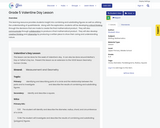
Unit 7 introduces students to an entirely new category of number—decimals. Students will explore decimals and their relationship to fractions, seeing that tenths and hundredths are particularly important fractional units because they represent an extension of the place value system into a new kind of number called decimals. Thus, students expand their conception of what a “number” is to encompass this entirely new category, which they will rely on for the remainder of their mathematical education.
Students have previously encountered an example of needing to change their understanding of what a number is in Grade 3, when the term came to include fractions. Their Grade 3 understanding of fractions (3.NF.A), as well as their work with fractions so far this year (4.NF.A, 4.NF.B), will provide the foundation upon which decimal numbers, their equivalence to fractions, their comparison, and their addition will be built. Students also developed an understanding of money in Grade 2, working with quantities either less than one dollar or whole dollar amounts (2.MD.8). But with the knowledge acquired in this unit, students will be able to work with money represented as decimals, as it so often is.
Thus, students rely on their work with fractions to see the importance of a tenth as a fractional unit as an extension of the place value system in Topic A, then expand that understanding to hundredths in Topic B. Throughout Topics A and B, students convert between fraction, decimal, unit, and expanded forms to encourage these connections (4.NF.6). Then students learn to compare decimals in Topic C (4.NF.7) and add decimal fractions in Topic D (4.NF.5). Finally, students apply this decimal understanding to solve word problems, including those particularly related to money, at the end of the unit. Thus, the work with money (4.MD.2) supports the major work and main focus of the unit on decimals.
While students will have ample opportunities to engage with the standards for mathematical practice, they’ll rely heavily on looking for and making use of structure (MP.7), particularly the structure of the place value system. They will also construct viable arguments and critique the reasoning of others (MP.3) using various decimal fraction models to support their reasoning.
- Subject:
- Mathematics
- Material Type:
- Assessment
- Homework/Assignment
- Lesson Plan
- Unit of Study
- Provider:
- Match Fishtank
- Date Added:
- 01/01/2017







